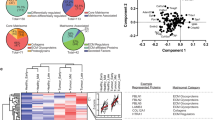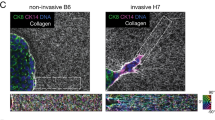Abstract
Increased stromal collagen deposition in human breast tumours correlates with metastases. We show that activation of the collagen I receptor DDR2 (discoidin domain receptor 2) regulates SNAIL1 stability by stimulating ERK2 activity, in a Src-dependent manner. Activated ERK2 directly phosphorylates SNAIL1, leading to SNAIL1 nuclear accumulation, reduced ubiquitylation and increased protein half-life. DDR2-mediated stabilization of SNAIL1 promotes breast cancer cell invasion and migration in vitro, and metastasis in vivo. DDR2 expression was observed in most human invasive ductal breast carcinomas studied, and was associated with nuclear SNAIL1 and absence of E-cadherin expression. We propose that DDR2 maintains SNAIL1 level and activity in tumour cells that have undergone epithelial–mesenchymal transition (EMT), thereby facilitating continued tumour cell invasion through collagen-I-rich extracellular matrices by sustaining the EMT phenotype. As such, DDR2 could be an RTK (receptor tyrosine kinase) target for the treatment of breast cancer metastasis.
This is a preview of subscription content, access via your institution
Access options
Subscribe to this journal
Receive 12 print issues and online access
$209.00 per year
only $17.42 per issue
Buy this article
- Purchase on Springer Link
- Instant access to full article PDF
Prices may be subject to local taxes which are calculated during checkout








Similar content being viewed by others
References
Kauppila, S., Stenback, F., Risteli, J., Jukkola, A. & Risteli, L. Aberrant type I and type III collagen gene expression in human breast cancer in vivo. J. Pathol. 186, 262–268 (1998).
Provenzano, P. P. et al. Collagen density promotes mammary tumor initiation and progression. BMC Med. 6, 11–26 (2008).
Paszek, M. J. et al. Tensional homeostasis and the malignant phenotype. Cancer Cell 8, 241–254 (2005).
Conklin, M. W. et al. Aligned collagen is a prognostic signature for survival in human breast carcinoma. Am. J. Pathol. 178, 1221–1232 (2011).
Valiathan, R. R., Marco, M., Leitinger, B., Kleer, C. G. & Fridman, R. Discoidin domain receptor tyrosine kinases: new players in cancer progression. Cancer Metastasis Rev. 31, 295–321 (2012).
Leitinger, B. Transmembrane collagen receptors. Annu. Rev. Cell Dev. Biol. 27, 265–290 (2011).
Perou, C. M. Molecular stratification of triple-negative breast cancers. Oncologist 15 (Suppl. 5), 39–48 (2010).
Thiery, J. P., Acloque, H., Huang, R. Y. & Nieto, M. A. Epithelial-mesenchymal transitions in development and disease. Cell 139, 871–890 (2009).
Moody, S. E. et al. The transcriptional repressor Snail promotes mammary tumor recurrence. Cancer Cell 8, 197–209 (2005).
Yang, J. et al. Twist, a master regulator of morphogenesis, plays an essential role in tumor metastasis. Cell 117, 927–939 (2004).
Drasin, D. J., Robin, T. P. & Ford, H. L. Breast cancer epithelial-to-mesenchymal transition: examining the functional consequences of plasticity. Breast Cancer Res. 13, 226–239 (2011).
Tran, D. D., Corsa, C. A., Biswas, H., Aft, R. L. & Longmore, G. D. Temporal and spatial cooperation of Snail1 and Twist1 during epithelial-mesenchymal transition predicts for human breast cancer recurrence. Mol. Cancer Res. 9, 1644–1657 (2011).
Franci, C. et al. Expression of Snail protein in tumor–stroma interface. Oncogene 25, 5134–5144 (2006).
Zhou, B. P. et al. Dual regulation of Snail by GSK- 3β-mediated phosphorylation in control of epithelial-mesenchymal transition. Nat. Cell Biol. 6, 931–940 (2004).
Yook, J. I. et al. A Wnt-Axin2-GSK3β cascade regulates Snail1 activity in breast cancer cells. Nat. Cell Biol. 8, 1398–1406 (2006).
Zhang, K. et al. Lats2 kinase potentiates Snail1 activity by promoting nuclear retention upon phosphorylation. EMBO J. 31, 29–43 (2011).
Egeblad, M., Rasch, M. G. & Weaver, V. M. Dynamic interplay between the collagen scaffold and tumor evolution. Curr. Opin. Cell Biol. 22, 697–706 (2010).
Schedin, P. & Keely, P. J. Mammary gland ECM remodeling, stiffness, and mechanosignaling in normal development and tumor progression. Cold Spring Harbor Perspect. Biol. 3, a003228 (2011).
Walker, R. A. The complexities of breast cancer desmoplasia. Breast Cancer Res. 3, 143–145 (2001).
Kreike, B. et al. Gene expression profiling and histopathological characterization of triple-negative/basal-like breast carcinomas. Breast Cancer Res. 9, R65 (2007).
Provenzano, P. P. et al. Collagen reorganization at the tumor–stromal interface facilitates local invasion. BMC Med. 4, 38–54 (2006).
Ferri, N., Carragher, N. O. & Raines, E. W. Role of discoidin domain receptors 1 and 2 in human smooth muscle cell-mediated collagen remodeling: potential implications in atherosclerosis and lymphangioleiomyomatosis. Am. J. Pathol. 164, 1575–1585 (2004).
Flynn, L. A., Blissett, A. R., Calomeni, E. P. & Agarwal, G. Inhibition of collagen fibrillogenesis by cells expressing soluble extracellular domains of DDR1 and DDR2. J. Mol. Biol. 395, 533–543 (2010).
Sivakumar, L. & Agarwal, G. The influence of discoidin domain receptor 2 on the persistence length of collagen type I fibres. Biomaterials 31, 4802–4808 (2010).
MacPherson, M. R. et al. Phosphorylation of serine 11 and serine 92 as new positive regulators of human Snail1 function: potential involvement of casein kinase-2 and the cAMP-activated kinase protein kinase A. Mol. Biol. Cell 21, 244–253 (2010).
Shin, S., Dimitri, C. A., Yoon, S. O., Dowdle, W. & Blenis, J. ERK2 but not ERK1 induces epithelial-to-mesenchymal transformation via DEF motif-dependent signaling events. Mol. Cell 38, 114–127 (2010).
Jacobs, D., Glossip, D., Xing, H., Muslin, A. J. & Kornfeld, K. Multiple docking sites on substrate proteins form a modular system that mediates recognition by ERK MAP kinase. Genes Dev. 13, 163–175 (1999).
Feng, Y. et al. A multifunctional lentiviral-based gene knockdown with concurrent rescue that controls for off-target effects of RNAi. Genom. Proteom. Bioinform. 8, 238–245 (2010).
Ikeda, K. et al. Discoidin domain receptor 2 interacts with Src and Shc following its activation by type I collagen. J. Biol. Chem. 277, 19206–19212 (2002).
Ding, Q. et al. Erk associates with and primes GSK- 3β for its inactivation resulting in upregulation of β-catenin. Mol. Cell 19, 159–170 (2005).
Desbois-Mouthon, C. et al. Insulin and IGF-1 stimulate the β-catenin pathway through two signalling cascades involving GSK- 3β inhibition and Ras activation. Oncogene 20, 252–259 (2001).
Ota, I., Li, X. Y., Hu, Y. & Weiss, S. J. Induction of a MT1-MMP and MT2-MMP-dependent basement membrane transmigration program in cancer cells by Snail1. Proc. Natl Acad. Sci. USA 106, 20318–20323 (2009).
Rowe, R. G. et al. Mesenchymal cells reactivate Snail1 expression to drive three-dimensional invasion programs. J. Cell Biol. 184, 399–408 (2009).
Cerami, E. et al. The cBio cancer genomics portal: an open platform for exploring multidimensional cancer genomics data. Cancer Discov. 2, 401–404 (2012).
Provenzano, P. P., Inman, D. R., Eliceiri, K. W. & Keely, P. J. Matrix density-induced mechanoregulation of breast cell phenotype, signaling and gene expression through a FAK-ERK linkage. Oncogene 28, 4326–4343 (2009).
White, D. E. et al. Targeted disruption of β1 integrin in a transgenic mouse model of human breast cancer reveals an essential role in mammary tumor induction. Cancer Cell 6, 159–170 (2004).
Mariotti, A. et al. EGF-R signaling through Fyn kinase disrupts the function of integrin α6β4 at hemidesmosomes: role in epithelial cell migration and carcinoma invasion. J. Cell Biol. 155, 447–458 (2001).
Soung, Y. H., Clifford, J. L. & Chung, J. Crosstalk between integrin and receptor tyrosine kinase signaling in breast carcinoma progression. BMB Rep. 43, 311–318 (2010).
Aiello, E. J., Buist, D. S., White, E. & Porter, P. L. Association between mammographic breast density and breast cancer tumor characteristics. Cancer Epid. Biom. Prev. 14, 662–668 (2005).
McDaniel, S. M. et al. Remodeling of the mammary microenvironment after lactation promotes breast tumor cell metastasis. Am. J. Pathol. 168, 608–620 (2006).
Sharp, T. V. et al. The chromosome 3p21.3-encoded gene, LIMD1, is a critical tumor suppressor involved in human lung cancer development. Proc. Natl Acad. Sci. USA 105, 19932–19937 (2008).
Livak, K. J. & Schmittgen, T. D. Analysis of relative gene expression data using real-time quantitative PCR and the 2(−ΔΔC(T)) method. Methods 25, 402–408 (2001).
Noordeen, N. A., Carafoli, F., Hohenester, E., Horton, M. A. & Leitinger, B. A transmembrane leucine zipper is required for activation of the dimeric receptor tyrosine kinase DDR1. J. Biol. Chem. 281, 22744–22751 (2006).
Acknowledgements
This work was supported by NIH grant P50CA94056 to the Imaging Core of the Siteman Cancer Center at Washington University, and NIH grants GM080673 and CA143868, and Susan G. Komen for the Cure KG110889 to G.D.L. C.A.C. was supported by NIH grant F31CA165729.
Author information
Authors and Affiliations
Contributions
K.Z., C.A.C., S.M.P. and J.L.P. were involved in project planning, experimental work and data analysis. D.P-W., K.W.E., P.J.K. and G.D.L. were involved in project planning and data analysis. G.D.L. wrote the manuscript. D.P-W. and P.J.K. provided editorial assistance in the writing of the manuscript.
Corresponding author
Ethics declarations
Competing interests
The authors declare no competing financial interests.
Supplementary information
Supplementary Information
Supplementary Information (PDF 4260 kb)
Supplementary Table 1
Supplementary Information (XLSX 12 kb)
Supplementary Table 2
Supplementary Information (XLSX 12 kb)
Supplementary Table 3
Supplementary Information (XLSX 26 kb)
Supplementary Table 41
Supplementary Information (XLSX 19 kb)
Rights and permissions
About this article
Cite this article
Zhang, K., Corsa, C., Ponik, S. et al. The collagen receptor discoidin domain receptor 2 stabilizes SNAIL1 to facilitate breast cancer metastasis. Nat Cell Biol 15, 677–687 (2013). https://doi.org/10.1038/ncb2743
Received:
Accepted:
Published:
Issue Date:
DOI: https://doi.org/10.1038/ncb2743
This article is cited by
-
DDR2-regulated arginase activity in ovarian cancer-associated fibroblasts promotes collagen production and tumor progression
Oncogene (2024)
-
Osteonectin bidirectionally regulates osteoblast mineralization
Journal of Orthopaedic Surgery and Research (2023)
-
Epithelial-to-mesenchymal transition in cancer progression: unraveling the immunosuppressive module driving therapy resistance
Cancer and Metastasis Reviews (2023)
-
Non-canonical functions of SNAIL drive context-specific cancer progression
Nature Communications (2023)
-
UBR5 targets tumor suppressor CDC73 proteolytically to promote aggressive breast cancer
Cell Death & Disease (2022)



